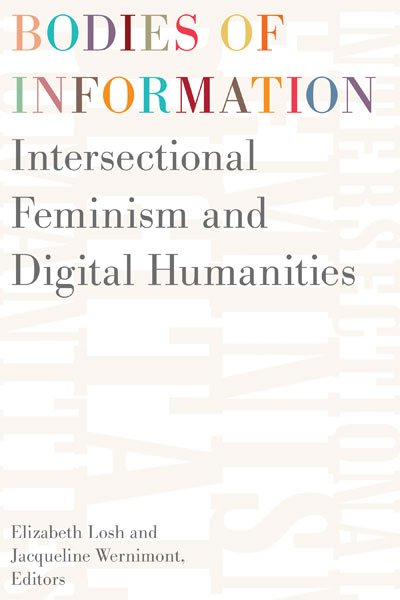Elizabeth Losh, Jacqueline Wernimont (eds.): Bodies of Information: Intersectional Feminism and Digital Humanities (2018)
Filed under book | Tags: · affect, body, digital humanities, feminism, intersectionality, labour, materiality, new materialism, ubiquitous computing

“In recent years, the digital humanities has been shaken by important debates about inclusivity and scope—but what change will these conversations ultimately bring about? Can the digital humanities complicate the basic assumptions of tech culture, or will this body of scholarship and practices simply reinforce preexisting biases? Bodies of Information addresses this question by assembling a varied group of voices, showcasing feminist contributions to a panoply of topics, including ubiquitous computing, game studies, new materialisms, and cultural phenomena like hashtag activism, hacktivism, and campaigns against online misogyny.”
Contributors: Babalola Titilola Aiyegbusi, Moya Bailey, Bridget Blodgett, Barbara Bordalejo, Jason Boyd, Christina Boyles, Susan Brown, Lisa Brundage, micha cárdenas, Marcia Chatelain, Danielle Cole, Beth Coleman, T. L. Cowan, Constance Crompton, Amy E. Earhart, Nickoal Eichmann-Kalwara, Julia Flanders, Sandra Gabriele, Brian Getnick, Karen Gregory, Alison Hedley, Kathryn Holland, James Howe, Jeana Jorgensen, Alexandra Juhasz, Dorothy Kim, Kimberly Knight, Lorraine Janzen Kooistra, Sharon M. Leon, Izetta Autumn Mobley, Padmini Ray Murray, Veronica Paredes, Roopika Risam, Bonnie Ruberg, Laila Shereen Sakr, Anastasia Salter, Michelle Schwartz, Emily Sherwood, Deb Verhoeven, Scott B. Weingart.
Publisher University of Minnesota Press, 2018
Debates in the Digital Humanities series, 4
Open Access
ISBN 9781517906108, 1517906105
xxv+491 pages
Fibreculture journal 19: Ubiquity (2011)
Filed under journal | Tags: · computing, pervasive computing, ubiquitous computing
Fibreculture Journal 19 deals with ubiquitous or pervasive computing, and with the recently emerged ambience of information. The issue details practices involving pervasive computing, both everyday practices and new art or dynamic architectural forms. Alongside these more practical concerns, the issue thinks through and with ubiquity. It takes ubiquity as something that has already arrived, something of immediate and increasing power. Simply put, ubiquity, by nature, is something with which we more often have to negotiate. Ubiquity’s ambiguous powers and possible futures also become key concerns. Finally, several articles consider the way that ubiquity might lead us to reconsider not only our past relationship to computing, but perhaps the very nature of computing and the human, vis a vis each other.
Articles include: Ulrik Ekman’s comprehensive introduction to the issues and ideas that move through ubiquity; Mette Ramsgard Thomsen and Karin Bech’s ‘Embedding response: self production as a model for an actuated architecture’; Anders Michelsen’s ‘ Pervasive Computing and Prosopopoietic Modelling: Notes on computed function and creative action’; Simon Penny’s ‘ Towards a Performative Aesthetics of Interactivity’; Christian Ulrik Andersen and Søren Pold’s ‘The Scripted Spaces of Urban Ubiquitous Computing: The experience, poetics, and politics of public scripted space’; Bo Kampmann Walther’s ‘Reflections on the Philosophy of Pervasive Gaming: With Special Emphasis on Rules, Gameplay, and Virtuality’; Matthew Fuller and Sónia Matos’ ‘Feral Computing: From Ubiquitous Calculation to Wild Interactions’; Malcolm McCullough’s ‘Toward Environmental Criticism’; Jonas Fritsch’s ‘Affective Experience in Interactive Environments’.
Issue edited by Ulrik Ekman
Publisher: Fibreculture Publications/The Open Humanities Press, Sydney, Australia, December 2011
ISSN: 1449 – 1443
PDF (PDF)
PDF (EPUB)
View online (HTML articles)
Christian Nold, Rob van Kranenburg: Situated Technologies Pamphlet 8: The Internet of People for a Post-Oil World (2011)
Filed under book | Tags: · climate crisis, internet, internet of things, oil, protocol, technology, ubiquitous computing
The authors articulate the foundations of a future manifesto for an Internet of Things in the public interest. Nold and Kranenburg propose tangible design interventions that challenge an internet dominated by commercial tools and systems, emphasizing that people from all walks of life have to be at the table when we talk about alternate possibilities for ubiquitous computing. Through horizontally scaling grass roots efforts along with establishing social standards for governments and companies to allow cooperation, Nold and Kranenberg argue for transforming the Internet of Things into an Internet of People.
Published by The Architectural League of New York, Spring 2011
ISBN 9780980099478
68 pages
Licensed under the Creative Commons Attribution-Noncommercial-Share Alike 3.0 Unported License


